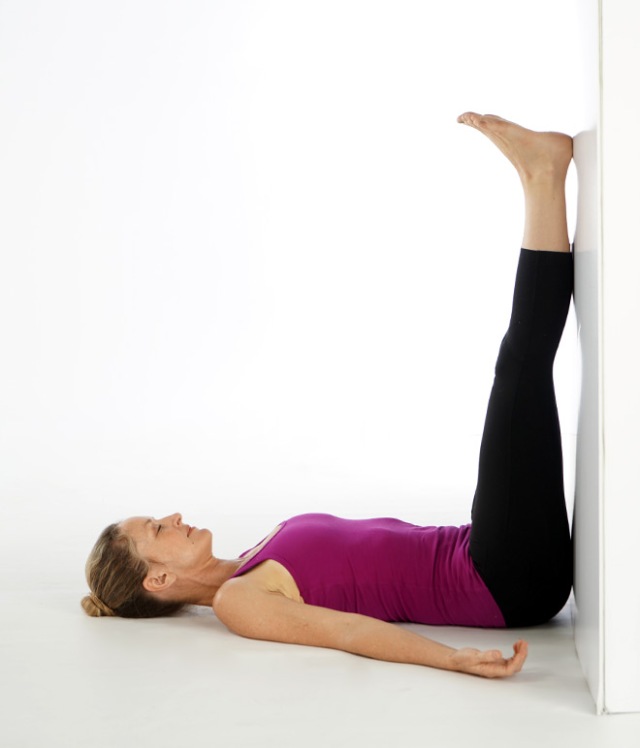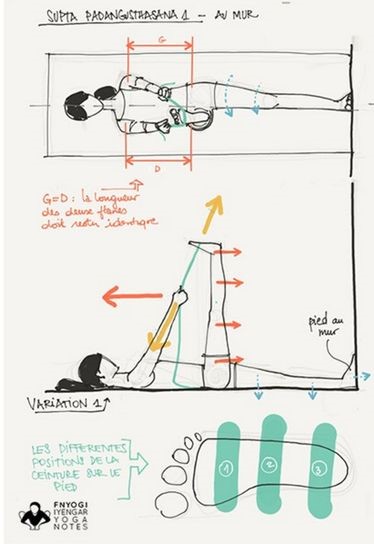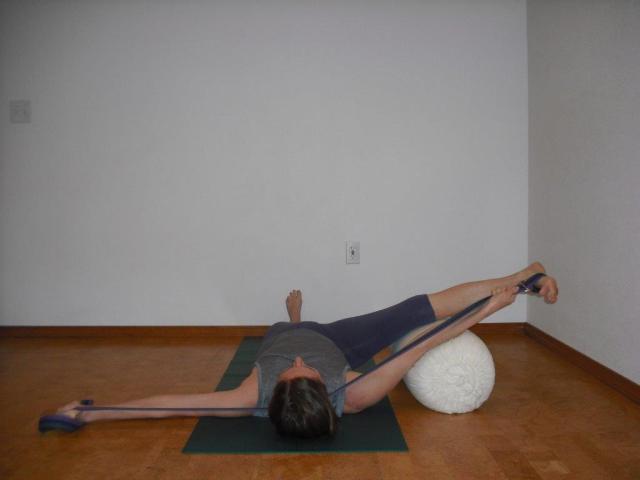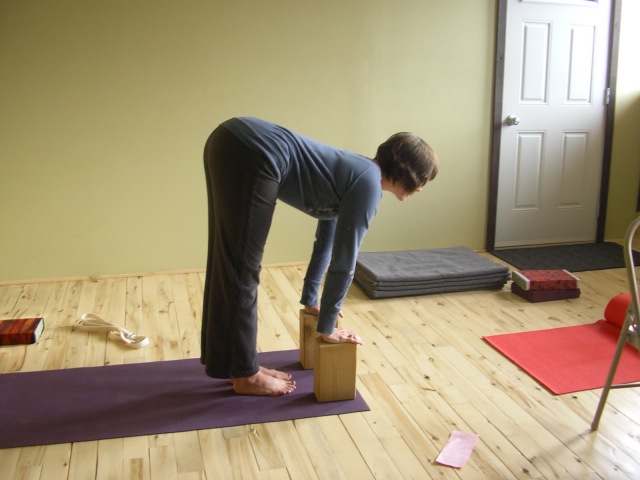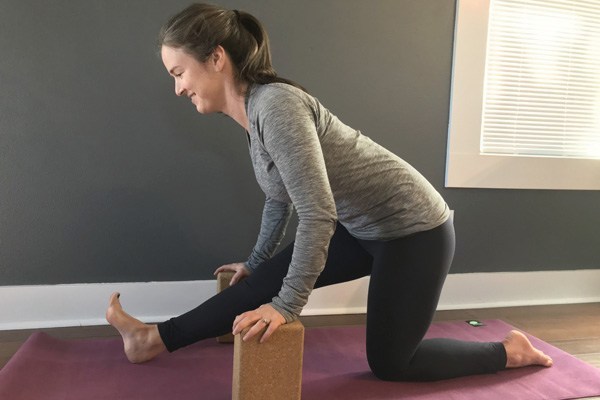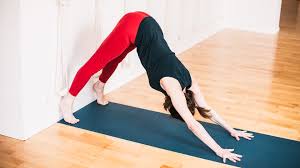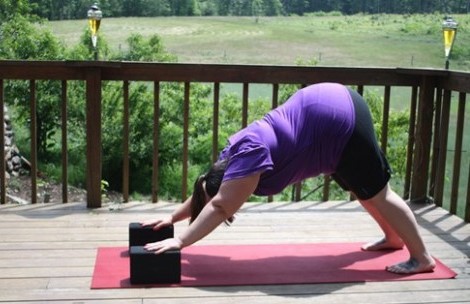This weekend I went to a workshop at the New York Institute with Rebecca Lerner. The theme of the workshop was the chapter 2 of Light on life, which was great for me, as I often lack in stability compared with flexibility. Also, light on life is my favorite yoga book and very high on my list of favorite books, and it was the first time I heard of someone having a workshop centered around a chapter of that book, so I was pretty excited.
There were three sessions: standing poses with a special attention to twists (Day 1), restorative & pranayama (Day 1), and finally arm balances and backbends (Day 2).
We started the standing poses session by working on parsva adho mukha virasana. Keeping the stabilizing arm (right arm while turning to the right) bent, extend the other arm as far forward as possible. Use your hand to help the belly to turn further, then extend again, and finally extend both arms. This created a very intense twist that one might not think possible in parsva adho mukha virasana.

Parsva adho mukha virasana with the stabilising arm bent by szkolajogi
After doing both sides two or three times, we went back to the center and up into Downward Dog. All following poses were stepped into from downdog and we changed sides sliding through prasarita padottonasana with a short rest with the head down. Rebecca mentioned that staying low would help both maintain the energy levels and help with the grounding and stability of the asanas.
The sequence itself was quite classic: parsvottanasana, parvritta trikonasana, parvritta parsvakonasana, parvritta ardha chandrasana. But the focus was on the revolving action, especially the turning from stability in the legs and the hips. She had us touch our hip bones and use our hands to give the right directions to the legs and the trunk. For exemple in parvritta trikonasana, she made us give the direction of inward rotation at the front hip bone to soften the abdomen and allow turning the chest from the stability in the hips. She mentioned that if this slight inward rotation was there, there would be no swaying of the hips on either side while we tried to turn. Furthermore, in all these poses she had us use our hand flat on the floor (as much as possible obviously, if you needed a brick you could use one) and stamp the heel of the hand down. I found it particularly helpful to work that way in terms of stability and connectivity for the shoulder.

Parvritta Parsvakonasana by BKS Iyengar
We then proceeded to sirsasana. There was much attention brought to the positioning of the hands; it seems we are often overcompensating the clasping of the hands and inward rotation of the wrist / lower arms. She had us clasp the hands but not so much that the thumbs would be crossing, simply resting on top of the index fingers. I had my small “yes!!!” moment when she mentioned bidirectionality in the arms, that we are used to going from the elbow to the wrist, but that we also need to learn going from the wrist to the elbow. This change in the hand position seemed to be very strange for most people and quite impactful, but I had been practicing that way for a while now, so it wasn’t a big shock to me. It was more of a shock that the way I was practicing headstand was seemingly not the “taught” way anymore; apparently along the way of home practice I improved (?) or at least let go of thing not serving me. I think at some point I was bringing in my elbows to close by in headstand which was creating issues with my neck, and when I went away from that my grip on the hands changed. I have also been practicing changing hand positions while in headstand quite a bit (I started doing that when I realized most of the weight was on my head anyhow, I could keep my shoulders lifted, and balance quite easily) and I believe that has improved my alignment, or vice-versa. Sometimes you’re really not sure of which came first…
We also practiced a few poses which are not in Light on Yoga, which was quite interesting. Rebecca mentioned that many poses didn’t make it into the final cut of LOY, as otherwise the book would have been too big and too expensive. We practiced two of those poses in headstand: parsva parvritta eka pada sirsasana (like parsva eka pada sirsasana but with the foot on the floor going to the direction of the foot still up, so if your right foot is touching down it would cross the midline towards your left) and akunchasana / parsva akunchasana: knees bent and thighs touching the chest, then swinging the knees to the right, staying and to the left, staying. My abs still remember this pose… But it was very interesting and I’m definitely gonna work on this pose more at home.

The only picture I could find of akunchasana, not sure where the credit is due, please let me know if you know…
Finally (I think, I’m not so sure anymore about the timeline) we finished the morning with mulabandhasana sitting on a bolster, then going into vamadevasana I from a kind of wide knee vajrasana. I was actually very surprised to see I could do this, as I had never even attempted that pose before! I had no idea where we were going and just found myself in the pose, which was a great beginner’s feeling I hadn’t had in a while.
Speaking of which, there were lots of talk about aparigraha and not coveting the neighbor’s pose and staying safe, in particular with all of these knee-heavy poses, which I thought Rebecca was very elegantly bringing into her teaching.
After a short viparita karani, we went for lunch, and reconvened two hours later for some digestive poses (supta virasana and supta badakonasana), shoulderstand and variations (we also practiced akunchasana / parsva akunchasana among other variations here, and Rebecca showed us how all the turning in parsva akunchasana was a great preparation for parsva sarvangasana as it enables us to bring the supporting hand really nicely under the tailbone. She also mentioned we could work on extending the legs in this pose using a chair to support the feet, which I’m really looking forward to work on at home). After this, we started pranayama, first lying down in supported savasana, then sitting, and we finished in prone savasana.
I always feel very inadequate writing about pranayama, as I feel very “meek” (Rebecca’s / Mr Iyengar’s words) in that practice. I do not practice pranayama very regularly. I feel guilty about not doing it more often, and I have started working on it a bit more (I even opened Light on Pranayama and read through some passages in the past few weeks) but I still feel very uncomfortable about giving pranayama instructions. However, I was surprised as I could easily sit through the whole session without fidgeting, which is definitely an improvement since teacher training. I guess all this sitting I’ve been doing is starting to bear its fruits. As for the pranayama itself, the only thing I will say is that we focused on keeping the chest bone / sternum lifted, and in particular lifted not only up (towards the head) but slightly forward (towards the front of the body) on the inhale.
